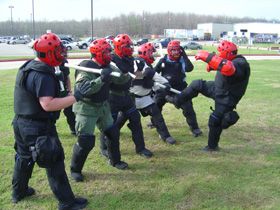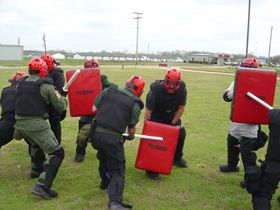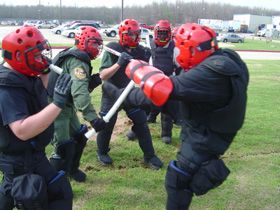Impact weapons serve one of the most important roles in any mini-team formation: they save the lives of the officers who deploy them. They are ultimately an extension of your arm, helping you create greater distance from the threat, and giving you the ability to hit harder and safer than you could by using your own hands.
Impact weapons have always provided officers with a positive visual deterrent, however, lately, due to the evolution of non-lethal weapon technology that allows officers to strike a subject down at greater distances, impact weapons have slowly faded from facilities’ armories. But it’s important to remember that impact weapons are there to save your life if non-lethal weapon technology fails, yet you still need to escalate to deadly force. It is then the impact weapon resumes its role as the life saver.
 Batons on Line Exercise: This is a controlled exercise where the offices only strike the target area within their own areas of respobilities. |
Professional visual deterrent
When an officer is standing on the line with the impact weapons drawn and in a carry position, there is a certain air about them — the air of confidence, motivation and certainty. Often this is all it takes for the inmates to stop being combative and to start complying.
Tip: Baton carries: A visual deterrent
Various carrying methods
- Baton rest: This carry position presents a very professional image and still allows the officer access to the baton in case of emergency. Having the officer stand with feet shoulder width apart and the baton held equally in both hands straight down in front of them with their arms extended.
- Low profile: This carry position presents a very professional image with the baton held in the strong hand down along their side with the striking end hidden behind the officer’s calf as they stand in the interview position.
- Command carry: This carry position presents a command image with the baton held in the strong, and the striking end centered between the officers bicep and lat muscle on their weak side, with the weak going under the baton and grabbing their own wrist on the strong hand.
- One-hand ready: This carry position is a high profile image with the baton held in the strong hand, and loaded at their shoulder of their strong side, standing in the interview position slightly bending at the knees with their weak hand up as to signal the subject they are confronting.
- Two-hand ready: This carry position is a high profile image with the baton held in both the strong and weak hand, with the striking end facing the threats and even with the officer’s elbows, standing in the interview position slightly bending at the knees.
- Port arms: This carry position is used when moving officers from one location to another while the baton is drawn. Simulating a military appearance with the baton held in both the strong and weak hand, with the striking end facing upwards at a 45’ degree angle going across the officers chest, standing in the interview position slightly bending at the knees.
Various types of impact weapons
Batons have come a long way from the over-shaped, uneven club of old, into impact weapons off all different shapes and sizes.
 Baton on Line Striking Drills: This drill reinforces line integrity, focusing on target area and listening to command. |
Straight stick: A great impact weapon of various lengths and weight; a one-piece made of wood, aluminum, metals or plastics. Carried on the side of the officer for easy access.
Advantages
- Would never malfunction when being used
- Great striking power
- Offers good blocking capabilities
Disadvantages
- Not secure in carrier
- Escort and restraints are limited
- Cumbersome for smaller officers
Side handle baton stick: Various lengths and weight; at one time made of two pieces with aluminum, polycarbonate and plastic materials. Carried on the side of the officer for easy access.
Advantages
- Excellent defensive tool for blocking
- Great for restraints
- Looks different. Professional visual deterrent
Disadvantages
- One piece side handles did not secure in carrier
- Collapsible side handles secured well
- Ineffective knockdown power from having to swing the side handle over conventional striking tactics
- Not instructed as an offensive tool
- Too time restricted to learn and maintain adequate skill level needed to survive an encounte
Baton deployment strategies
 Baton On Line Drill: This drills focuses on selecting your target area, working as a team and areas of responsibilities. |
- Combine verbal directions with physical alternatives
- Evaluate the response from the inmate after deploying
- Survey the area for additional threats
- Maintain your alignment and do not drift from line
- Never hit in the same place more than once if possible
- If you drop the baton on the line have a plan for retrieving it
- Practice your baton strikes wearing all of your assigned duty gear to include you protective mask
- Practicing striking on line and in close quarter areas
- Build yourself up for striking drills at 15-30-60-90 second intervals
- Have a plan for retaining your baton if someone tries to take it from you
Advantages
Disadvantages
Rapid Rotation Baton: A great hybrid impact weapon. Taking the best of the straight, side handle and expandable batons and rolling them into one. Various lengths and weight made of one piece made materials of special proprietary materials. Carried behind the officer’s firearm for easy access.
Advantages
Disadvantages
(Worth taking a look at it)
Striking tactics
Striking with a baton physically demanding, but also necessitates a mental commitment. You need to be cognitive of where others are around you; you have to know how to hit the target you are aiming at. All of this takes practice. Practice takes time, and you need to dedicate yourself to this time in order to become proficient.
- Forward Strike: Holding the baton in a one-hand ready position in your strong arm to swing the baton in a forward motion. This is definitely the most powerful of strikes, giving the officer the ability to hit a target with enough power to physically knock the aggressor to the ground and/or stop their aggressive and resistant behavior.
- Reverse Strike: This is the return swing of the forward strike. Definitely not the most powerful of strikes. Providing the officer the ability to hit a target while recovering from a forward strike.
- Cutting the Grass: Holding the baton in a one-hand ready position in your strong arm to rapidly swing the baton in a forward motion low across the shin area of the inmate. Providing the officer the ability to strike several times target with enough power to make a inmate move backward and away from you.
- Middle strike: Holding the baton in a two-hand ready position, bringing the baton across your body and, using a pushing motion, striking the subject with the center of the baton to push them him off the line.
- Two-hand jab: Holding the baton in a two-hand ready position, jab outwards away from your body using a forward pushing motion striking the subject with the striking end of the baton to target the lower abdominal and push them off the line.
Target areas
We are not going to address this area in the same manner that it has been addressed for the last 40 years. When you strike a target area on an inmate, you need to do the math.
If an inmate has his fists up and is trying to punch you in the head, we could all reasonable assume that he is trying to cause serious harm which may result in your death. Legally you would by justified in escalating to deadly force, and be legally supported if you were to strike the subject in areas that could cause harm, and that may result in death.
However, in the training we have been teaching officers to strike the thigh of an inmate, which when struck could cause little to no harm to the inmate and allow them to continue fighting. Striking the thigh of a combative inmate causes no real incentive for the inmate to stop his assault, and will bring you much closer to the threat, leaving the officer in greater danger, whereas striking their arms and hands while they punch you, and striking their feet or shins when they kick you, will allow you to have a greater chance in stopping the threat because you are striking the inmate’s own delivery systems.
You need to adopt a fighting philosophy. My philosophy with fighting has always been this: Take away the attacker’s own weapons, “plus no one has ever died from a broken arm or shin that I know of, however officers have been seriously injured trying to strike less effective target areas.”
And you may ask why have we taught this softer approach to personal defense and use of force? Well because we as a society think an officer needs to show compassion even during times where someone is trying to kill us. I would like to introduce this new and effective philosophy.
If an inmate is trying to punch you, strike their arm. If the inmate is trying to kick you strike the bridge of their foot. No one has died from a broken are or foot. However officers have died from being punched and kicked! You need to ask yourself why I would strike an inmate in the thigh when they are trying to punch me in the head.
If you were an inmate, where you rather be hit with a baton? The arm or leg where it would hurt more and most likely stop your ability to continue fighting, or the thigh where you can take a large amount of blunt force trauma and still continue to fight?
Do the math!












